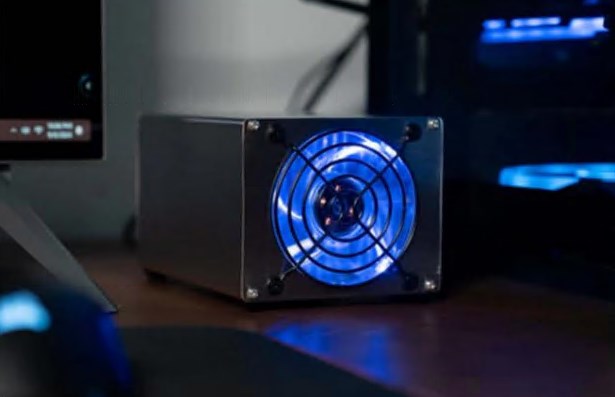As Bitcoin continues to solidify its place in the global financial system, more people are exploring ways to participate in its creation. With institutional adoption growing, regulatory clarity improving, and Bitcoin’s price reaching new highs in 2025, home mining has regained interest.
If you’re considering mining Bitcoin from home, here are four realistic approaches—each with its own risks, costs, and potential rewards.
Contents
Table of Contents
1. Lottery Mining: Low-Cost, High-Risk, Rare Wins
For those who want to dip their toes into mining without major investments, lottery mining offers an intriguing—albeit highly unpredictable—option.
In mid-2024, a solo miner using just 3 TH/s (equivalent to two small USB miners) defied astronomical odds and successfully mined a full Bitcoin block, earning 3.192 BTC (worth over $200,000 at the time). While such wins are extremely rare, they keep hobbyists engaged.
How It Works:
- Miners use low-power devices like the Bitaxe HEX (~3 TH/s, ~$600) or GekkoScience R909 (~1.5 TH/s, USB-powered).
- These miners connect to Solo CKPool, a platform that lets independent miners submit shares directly to Bitcoin’s network.
- If you find a block, you keep the full reward (minus a small pool fee).

GekkoScience R909
Why Do It?
- Supports Bitcoin’s decentralization.
- Educational—helps you understand mining mechanics.
- The thrill of a potential jackpot (even if unlikely).
This method is more about participation than profit, making it ideal for tinkerers and Bitcoin enthusiasts.
2. Solo ASIC Mining: High-Stakes, High-Reward (But Low Odds)
If you’re willing to invest in serious hardware, ASIC miners (Application-Specific Integrated Circuits) offer a more powerful—but still risky—path.

A DIY ASIC mining setup
The Numbers in 2025:
- The Bitcoin network’s hashrate hovers around 500 EH/s.
- A top-tier miner like the Antminer S21 Hydro (~400 TH/s) gives you ~0.00008% of the network’s power.
- Your odds of finding a block solo? Roughly 1 in 8.6 billion per day.
Scaling Up Improves Odds (Slightly)
Running 20 ASICs (~8 PH/s) could theoretically land you one block per year. But this requires:
- High upfront costs (~$16 per terahash in 2025).
- Proper cooling (immersion or advanced ventilation).
- Reliable, cheap electricity.
The Appeal:
- Full block rewards (3+ BTC + fees) go entirely to you.
- No sharing profits with a pool.
However, this remains a high-risk, high-reward gamble—most miners opt for steadier returns via pools.
3. Pool Mining: Consistent (If Smaller) Rewards
For most home miners, joining a mining pool is the most practical way to earn Bitcoin.
How It Works:
- You combine your hashrate with thousands of others.
- When the pool finds a block, rewards are split based on contribution.
- Payout models include:
- FPPS (Full Pay Per Share) – Steady payouts per valid share.
- PPLNS (Pay Per Last N Shares) – Higher rewards when blocks are found but less predictable.
Setup Steps:
- Choose a reputable pool (e.g., Foundry USA, Antpool, ViaBTC).
- Connect your ASIC miner to the pool’s server.
- Enter your Bitcoin payout address.
- Monitor earnings via the pool’s dashboard.
Why Pools Win:
- Steady income (no waiting years for a solo block).
- Lower variance than solo mining.
- Easier to scale with additional hardware.
If you want reliable payouts, this is the best home mining strategy.
4. Cloud Mining: Convenient but Often Unprofitable
For those who want to avoid hardware hassles, cloud mining lets you rent hash power from a provider.
The Pros & Cons:
✅ No equipment maintenance or noise.
✅ No electricity costs (baked into contracts).
❌ Historically scam-heavy industry.
❌ Thin profit margins after fees.
Reputable Providers (2025):
- NiceHash (flexible, short-term contracts).
- BitDeer (transparent pricing).
- ECOS (long-term contracts).
When It Makes Sense:
- You lack space or cheap electricity.
- You want passive exposure to mining (but buying BTC may be simpler).
Warning: Many cloud mining contracts end up unprofitable—do thorough research before committing.
Final Verdict: Which Method is Best for You?
| Method | Cost | Risk Level | Reward Potential | Best For… |
|---|---|---|---|---|
| Lottery Mining | Low (100−100−600) | Very High | Rare jackpot wins | Hobbyists, learners |
| Solo ASIC | High (5K−5K−50K+) | High | Full block rewards | High-risk takers |
| Pool Mining | Moderate (2K−2K−20K) | Medium | Steady small payouts | Most home miners |
| Cloud Mining | Variable (contract-based) | Medium-High | Low, passive income | Hands-off investors |
Key Takeaways:
- For fun & learning? Try lottery mining.
- For serious but risky rewards? Go solo ASIC.
- For steady income? Join a mining pool.
- For convenience? Cloud mining (but be cautious).
Bitcoin mining in 2025 is more accessible than ever—but success depends on your goals, budget, and risk tolerance. Choose wisely! 🚀
Also Read this..




